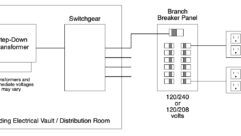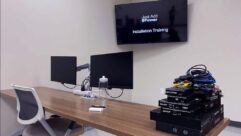Displays of Power
Sep 1, 2001 12:00 PM,
PETER H. PUTMAN, CTS
IN THE LAST ISSUE, I BEGAN THE PROCESS OF WRAPPING UP INFOCOMM 2001. With the overwhelming number of video display technologies introduced there, it’s no wonder I couldn’t finish in one sitting. At least I got to address the Projection Shoot-Out — many people’s favorite event at INFOCOMM. This event may be changing formats, it turns out, as more and more key manufacturers take themselves out of the head-to-head competition to concentrate on their booth presence. By next year, the Projection Shoot-Out may morph into part of the Display Systems Encounter. And the feeling is that INFOCOMM would still be the strong, unique trade show that it is, even without the Shoot-Out, should it come to that. Meanwhile, more attention at the show is turning toward the growing number — and flourishing quality — of educational seminars, increased booth-space sales and the great networking opportunities to be had.
Last issue of S&VC, I discussed the new projectors I saw at the Las Vegas technology show. Overall, the advances this year were lighter on technological breakthroughs and heavier on market-share competition. Companies had expanded existing lines, and aggressive pricing was the rule of the day. Similar themes existed for plasma display panels and datawalls.
PLASMA DISPLAY PANELS: MORE OPTIONS AND PLUMMETING PRICES
Although this category wasn’t anywhere as crowded as the projectors category, there still were plenty of products to see:
Samsung, with its recently formed professional A/V division, displays enthusiasm. Why not, when it has a full range of 16:9 plasma panels, from the 42-inch SPD-42P1SM (852×480 wide VGA) to the 50-inch SPD-50P2HM (1366×768 wide XGA) and the 63-inch SPD-63P1HM (also 1366×768 wide XGA)? The latter is currently the largest plasma panel for sale. All of Samsung’s panels measure just over 3.3 inches thick, and they’re not too heavy — even the 63-inch model weighs only 150 pounds.
Sony showed the panel that started the recent price wars, the 16:9, 1024×1024, 3.25-inch-thick PFM-42B1. Supposedly, Sony can’t keep up with the orders. (These have gone as low as $6300 online.) This was also the first Sony panel to have IP connectivity through a side slot. A 50-inch panel was expected but hasn’t arrived yet.
Sanyo sells plasma, too. It’s just hard to find behind all of the projectors on display. The PDP-42H1A is a 42-inch, 16:9 HD (1024 by 1024) panel, which in all likelihood originated in the Hitachi/Fujitsu factory. The PDP-32H1A 32-inch, 16:9 panel has an oddball resolution of 852×1024 pixels.
Toshiba jumped on the 50-inch bandwagon with the 50HP81, equipped with Toshiba’s ColorStream progressive-scanning technology and with a native pixel count of 1366 by 768 (wide XGA).
NEC‘s newest flat panel is the PlasmaSync 61MP1, which (for a short while) was the largest commercially available PDP. This monster features 1365×768 wide-XGA resolution, 3:2 pulldown detection and compensation, built-in split screen imaging and digital zoom.
Hitachi brought its 42-inch CMP4120HDU (16:9, 1024×1024) and 37-inch CMP307XU (4:3, 1024×768) plasma panels.
JVC showed the new 50-inch GD-V500PZU with a native pixel count 1366 by 768.
Panasonic‘s 16:9 TH-50PHD3U is significant for lowering the industry’s MSRP on 50-inch panels to $13,995; and it also incorporates the super-rich blacks and enhanced video signal processing of its 42-inch companion, the TH-42PWD3.
Pioneer‘s PDP-503MX FlexPlasma is perhaps the first configurable plasma panel. An expansion card slot allows plug-in of analog and digital interface cards. This 16:9 panel has 1280×768 wide-XGA resolution and remains the lightest PDP at just under 90 pounds.
Fujitsu is a mover and shaker in the PDP makret, and it provided more than a couple of surprises. The new PDS-5001, a 50-inch 16:9 panel (seen at Winter CES), features 1365×768 wide-XGA resolution, is less than 4 inches thick, and has seriously high contrast. This unit is bright! The 16:9, 42-inch PDS-4241 is a much brighter version of the PDS-4221 with quieter fans. The pixel resolution is 1204 by 1024, and the unit incorporates a proprietary Advanced Video Movement DSP.
To keep up with Sony, Fujitsu also announced the relatively inexpensive PDS-4229AG. It’s a stripped-down 1024×1024 panel with the AVM processor, retailing for $6999 — about $1000 less than the PFM-42B1. (Here we go again with the pricing wars.)
DATAWALLS AND LARGE-SCREEN DISPLAYS: BIGGER, BRIGHTER, MORE FLEXIBLE
The datawall nee videowall category continues to be strong:
Clarity rolled out a few new rear-projection cubes and standalone displays, most notably the Lion WN-6720-UX, a 67-inch AP/LCD display for 24/7 command and control and financial applications, available in XGA and SXGA resolution. The Panther PN-6730-UX is a standalone super-high-resolution display that also measures 67 inches and is intended for conference and meeting rooms.
Samsung‘s ferro-electric LCD RP displays are capable of true 1280×720 resolution, using three FeLCD LCoS panels. The 43-inch display shown with these panels measures 15.7 inches deep. Samsung also showed the SV-50P1F, a 50-inch FeLCD RP cube in a 16:9 aspect ratio, and a 50-inch FeLCD RP monitor (ST-506WM, also 16:9). It will be interesting to see if the RP monitor category comes back; it’s been all but demolished by plasma in the professional A/V market.
Mitsubishi was the first DLP OEM to build 1024×768 RP cubes. At INFOCOMM, the company showed the MegaView datawall, made up of individual 50-inch RP cubes using 0.7-inch, 1024×768 DMDs. Each cube measures about 26 inches deep.
Christie showed its unique RP cubes, the GraphXMaster CX5-100U (XGA DMD, 50-inch diagonal, 24 inches deep) and the GraphXMaster CX60-100U (XGA DMD, 60-inch diagonal, 27 inches deep).
Toshiba showed the 50-inch (4:3) P500DL, a rear-projection cube that uses a 0.7-inch DMD and measures just over 21 inches in depth. There’s a companion P402LC 40-inch LCD rear-projection cube, too.
Olympus showed the VisionPlex HDPS-100, 100-inch (16:9) rear-projection standalone display. This RP monitor uses nine separate SVGA LCD projectors to achieve an amazingly bright image with over four million pixels of resolution in a 1300-pound cabinet.
ComView Visual Systems is coming on strong with a full line of RP monitors and datawall cubes. ViewBoard is a seamless modular datawall that can use either 52-inch SVGA or 52-inch XGA DLP projection cubes, while the ViewScreen is a panoramic display that uses custom soft-edge blending from rear projectors. It works with flat or curved screens. Finally, the ViewMaestro is a custom multichannel controller for image manipulation on any ComView product.
Electrosonic showed the final version of its Vector Director image control software. This program is now more user-friendly for the corporate world. It processes video image and position choices in real time and supports two video/SVGA sources and one HD/SXGA source simultaneously, and can drive two separate progressive-scan outputs at up to 1280×1024-pixel resolution.
SCALERS AND INTERFACES: SOME INTERESTING INVENTIONS
There were scads of interfaces to be seen in Las Vegas. Here’s a sampling:
Kramer Electronics entered the interface market with a full line of inexpensive products. Of interest were the VP-series matrix switchers, including the VP-1616 (16×16 RGBHV), VP-3216 (32×16 RGBHV) and VP-3232 (32×32 RGBHV) models. There were also six new scan converters including a unique vertical-mount VP-701SC VGA/SVGA/XGA model, and the VP-706SC full-featured scan converter with genlock. Three video scalers rounded out the picture: the VP-721DS (up to XGA output with single-input VGA switcher), VP-722DS (similar, but with a 4-input switcher), and the VP-770DS (converts up to SXGA output or 480p, 720p, 1080i and 1080p rates).
Communications Specialties brought several models of its new Deuce MC and Deuce HD scalers. The Deuce MC converts video to five different output rates, including 800 by 600, 852 by 480 (for plasma) and 1024 by 768, while the Deuce HD converts to DTV-standard rates (480p, 720p, 1080p) plus SXGA and wide XGA (1366 by 768).
Faroudja‘s Native Rate Series processor is built to optimize mid-price, fixed-installation digital LCD, DLP and plasma. Scan rates can be optimized for 480p screens, 852×480 plasma, 800×600 projectors, 16:9 HD displays, 1024×768 projectors, 1366×768 plasma, ALIS plasma, and D-ILA projectors. They’re nicely priced, too, at $3995 apiece.
InLine showed the IN1408 Video/DVI Scaler, one of the least expensive scalers I’ve seen that supports DVI format (not very popular so far). It handles video and RGB signals up to 1600 by 1200 and outputs analog RGB, analog YPbPr and DVI simultaneously. It has eight inputs, four with audio-follow switching.
Analog Way had yet another preliminary video scaler/switcher on display. The Trans-Scaler XT has seven signal inputs (six video in composite, S-video and component formats, plus one VGA) and provides one scaled output at any resolution from 640 by 480 up to 1365 by 1024, including HD-standard rates of 480p and 720p.
Folsom Research‘s Presentation Pro installation scaler functions in a 2RU design with seven universal video/RGB inputs and stereo audio-follow switching. This product is intended to give conference and boardroom users the same seamless blending found in Folsom’s ScreenPro products used for staging.
Extron Electronics had a big rollout of interfaces for virtually every application. The DDS402 scaler can convert video to any of 33 different output rates, while the USP 405 Universal Signal Processor is even more impressive, literally converting any signal to any other signal format, interlaced or progressive. The USP 405 accepts RGB, HD component, SDI, S-video and composite sources, and all video sources can be transcoded to all output connectors.
Extron also unveiled a new line of ISM-series integration scaling matrix switchers, video scaler/switchers for the installation market. The ISM 108 offers eight video inputs that can be configured for component or composite input, and two high-resolution RGB outputs using 5×BNCs or 15-pin VGA jacks. (The ISM 408 adds HDTV compatibility.) For audio follow, the ISM 182 and ISM 482 models are also available.
Extron’s MediaLink is billed as a one-touch A/V system control. The MLC 206 is a remote control panel for universal operation of room devices and projectors, including a full line of MediaLink video and RGB switchers. Currently, MediaLink can provide remote control of power on/off, input switching and volume, using the 6-input MLS 306 switcher, the MLS 506 (2RU enclosure, all BNCs), the MLS 506MA (built-in 30-watt mono amplifier), and MLS 506SA (built-in 30-watt stereo amplifier).
This year’s INFOCOMM was a show to remember no so much for unprecidented advances in technology as for competitive moves for market share and broadening of capabilities. And it marked some changes and growth at INFOCOMM itself with a glittery new home base and booming attendance and education.
Peter H. Putman owns PHP Communications in Doylestown, Pennsylvania. He has been reviewing INFOCOMM’s products and events since 1994.
BEST IN SHOW
Significant technological advances or overall excellence distinguishes these display products:
Samsung
SPD-63P1HM
A 63-inch PDP, currently the largest single panel on the market.
Panasonic
TH-50PHD3U
This 16:9, 50-inch panel has lowered MSRP to just under $14,000.
Pioneer
PDP-503mX
FlexPlasma
Perhaps the first configurable plasma panel.
Clarity
Lion WN-6720-UX
A 67-inch rear-projection AP/LCD display for financial applications.
Clarity Panther
PN-6730-UX
Another standalone, high-resolution display, this one for conference and meeting rooms.
Mitsubishi
MegaView Datawall
Made up of 50-inch rear-projection cubes.
Olympus
VisionPlexHDPS-100
A 100-inch rear-projection standalone display using nine SVGA LCD projectors for a super-bright image.
Faroudja
Native Rate Series
Optimizes fixed-installation digital LCD, DLP and plasma scan rates.
Extron USP 405
This universal signal processor literally converts any signal format to any other signal format.









